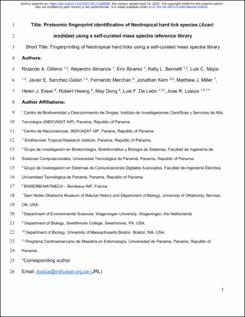| dc.contributor.author | Gittens, Rolando A. | |
| dc.contributor.author | Almanza, Alejandro | |
| dc.contributor.author | Álvarez, Eric | |
| dc.contributor.author | Bennett, Kelly L. | |
| dc.contributor.author | Mejía, Luis C. | |
| dc.contributor.author | Sanchez-Galan, Javier E. | |
| dc.contributor.author | Merchan, Fernando | |
| dc.contributor.author | Kern, Jonathan | |
| dc.contributor.author | Miller, Matthew J. | |
| dc.contributor.author | Esser, Helen J. | |
| dc.contributor.author | Hwang, Robert | |
| dc.contributor.author | Dong, May | |
| dc.contributor.author | De León, Luis F. | |
| dc.contributor.author | Loaiza, Jose R. | |
| dc.date.accessioned | 2020-06-27T04:43:58Z | |
| dc.date.available | 2020-06-27T04:43:58Z | |
| dc.date.issued | 2020-04-14 | |
| dc.identifier.other | https://www.biorxiv.org/content/10.1101/2020.04.13.040089v1 | |
| dc.identifier.uri | http://repositorio-indicasat.org.pa/handle/123456789/129 | |
| dc.description | Matrix-assisted laser desorption/ionization (MALDI) time-of-flight mass spectrometry is an analytical method that detects macromolecules that can be used as biomarkers for taxonomic identification in arthropods. The conventional MALDI approach uses fresh laboratory-reared arthropod specimens to build a reference mass spectra library with high-quality standards required to achieve reliable identification. However, this may not be possible to accomplish in some arthropod groups that are difficult to rear under laboratory conditions, or for which only alcohol preserved samples are available. Here, we generated MALDI mass spectra of highly abundant proteins from the legs of 18 Neotropical species of adult field-collected hard ticks, several of which had not been analyzed by mass spectrometry before. We then used their mass spectra as fingerprints to identify each tick species by applying machine learning and pattern recognition algorithms that combined unsupervised and supervised clustering approaches. Both principal component analysis (PCA) and linear discriminant analysis (LDA) classification algorithms were able to identify spectra from different tick species, with LDA achieving the best performance when applied to field-collected specimens that did have an existing entry in a reference library of arthropod protein spectra. These findings contribute to the growing literature that ascertains mass spectrometry as a rapid and effective method for taxonomic identification of disease vectors, which is the first step to predict and manage arthropod-borne pathogens.
Author Summary Hard ticks (Ixodidae) are external parasites that feed on the blood of almost every species of terrestrial vertebrate on earth, including humans. Due to a complete dependency on blood, both sexes and even immature stages, are capable of transmitting disease agents to their hosts, causing distress and sometimes death. Despite the public health significance of ixodid ticks, accurate species identification remains problematic. Vector species identification is core to developing effective vector control schemes. Herein, we provide the first report of MALDI identification of several species of field-collected Neotropical tick specimens preserved in ethanol for up to four years. Our methodology shows that identification does not depend on a commercial reference library of lab-reared samples, but with the help of machine learning it can rely on a self-curated reference library. In addition, our approach offers greater accuracy and lower cost per sample than conventional and modern identification approaches such as morphology and molecular barcoding. | en_US |
| dc.description.abstract | Matrix-assisted laser desorption/ionization (MALDI) time-of-flight mass spectrometry is an analytical method that detects macromolecules that can be used as biomarkers for taxonomic identification in arthropods. The conventional MALDI approach uses fresh laboratory-reared arthropod specimens to build a reference mass spectra library with high-quality standards required to achieve reliable identification. However, this may not be possible to accomplish in some arthropod groups that are difficult to rear under laboratory conditions, or for which only alcohol preserved samples are available. Here, we generated MALDI mass spectra of highly abundant proteins from the legs of 18 Neotropical species of adult field-collected hard ticks, several of which had not been analyzed by mass spectrometry before. We then used their mass spectra as fingerprints to identify each tick species by applying machine learning and pattern recognition algorithms that combined unsupervised and supervised clustering approaches. Both principal component analysis (PCA) and linear discriminant analysis (LDA) classification algorithms were able to identify spectra from different tick species, with LDA achieving the best performance when applied to field-collected specimens that did have an existing entry in a reference library of arthropod protein spectra. These findings contribute to the growing literature that ascertains mass spectrometry as a rapid and effective method for taxonomic identification of disease vectors, which is the first step to predict and manage arthropod-borne pathogens.
Author Summary Hard ticks (Ixodidae) are external parasites that feed on the blood of almost every species of terrestrial vertebrate on earth, including humans. Due to a complete dependency on blood, both sexes and even immature stages, are capable of transmitting disease agents to their hosts, causing distress and sometimes death. Despite the public health significance of ixodid ticks, accurate species identification remains problematic. Vector species identification is core to developing effective vector control schemes. Herein, we provide the first report of MALDI identification of several species of field-collected Neotropical tick specimens preserved in ethanol for up to four years. Our methodology shows that identification does not depend on a commercial reference library of lab-reared samples, but with the help of machine learning it can rely on a self-curated reference library. In addition, our approach offers greater accuracy and lower cost per sample than conventional and modern identification approaches such as morphology and molecular barcoding. | en_US |
| dc.language.iso | eng | en_US |
| dc.rights | https://creativecommons.org/licenses/by-nc-sa/4.0/ | |
| dc.rights | info:eu-repo/semantics/openAccess | |
| dc.subject | fingerprint identification | en_US |
| dc.subject | Neotropical | en_US |
| dc.subject | hard tick species | en_US |
| dc.subject | reference library | en_US |
| dc.title | Proteomic fingerprint identification of Neotropical hard tick species (Acari: Ixodidae) using a self-curated mass spectra reference library | en_US |
| dc.type | info:eu-repo/semantics/article | en_US |
| dc.type | info:eu-repo/semantics/publishedVersion | |

